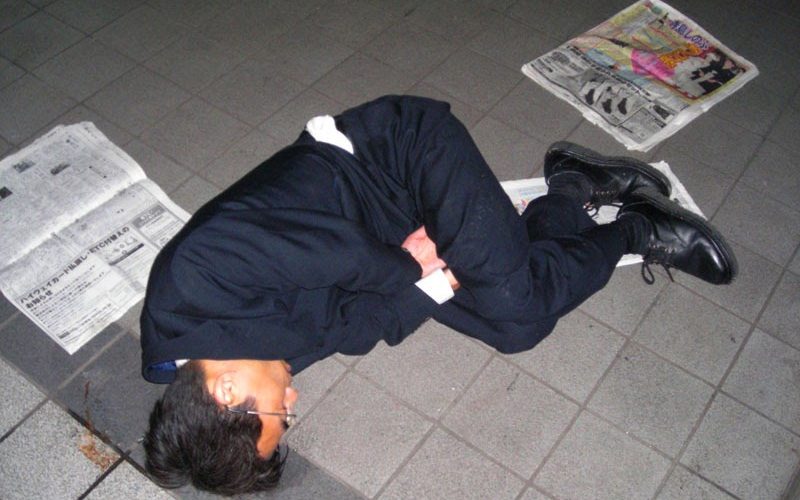In July 2013, Miwa Sado logged 159 hours of overtime work and took only two days off. She then died of heart failure.
Less than two years later, Matsuri Takahashi died by suicide after consistently logging more than one hundred overtime hours per month. Before her suicide, she tweeted “I want to die” and “I’m physically and mentally shattered.”
Hundreds of Japanese workers die annually from karoshi—“death by overwork”—through strokes, heart attacks, and suicide. While the Labour Standards Law sets the average work week at forty hours, it does not adequately regulate overtime. Instead of setting a strict cap, it allows employers and trade unions/representatives to determine overtime hours.
In 2016, it was estimated that one in five workers were at risk of karoshi. A government survey from the same year found that nearly a quarter of surveyed companies mandated that their employees work more than eighty overtime hours, often unpaid. An Expedia study also found that most employees do not use their ten paid vacation days. In response, the government passed a work style reform bill in 2018, limiting overtime to one hundred hours per month and fining violators up to ¥300,000 (approximately $2,800) per violation. It entered into force in April 2019 for large companies and a year later for small and medium-sized ones.
While this law seemed to be a step forward, it was actually two steps back. The “karoshi line,” the point at which people risk death or illness, is eighty hours per month, twenty fewer than the legal limit. The cap does not apply to skilled workers making more than ¥10.75 million ($100,000) per year, meaning these workers must choose between their salary and health. Because the bill also excludes discretionary labor, companies can pressure their employees into unpaid work to circumvent the cap. For example, at Dentsu Inc., where Takahashi worked, many employees were told to underreport their overtime hours.
Economic incentives explain the bill’s passage. Japan has a severe labor shortage, so businesses lack the manpower to operate at full capacity. Overtime work maximizes output and keeps companies afloat. The challenge for Japan lies in addressing karoshi without harming the economy.
To do so, the government must address the labor shortage. This could be done by employing more women, young people, or old people. It could be done through immigration or automation. But none of these solutions will be viable until the government removes the roadblocks in their way.
Historically Pervasive, Culturally Devastating
Japan’s overwork problem is not new. For decades, employees have clocked long hours, worked rigid schedules, and rejected annual leave. After World War II, Japan struggled to cope with defeat, occupation, and an insecure future. Most people threw themselves into work, fueled by a toxic, ingrained work culture. In a culturally homogenous country, collectivism is valued above individualism, as people prioritize the group’s success over their own. Employees show their commitment and loyalty toward their employers through overwork.
As Japan began to rebuild, the government aimed to kickstart reconstruction by investing in steel, iron, and coal mining. These industries—with nearly ¥750 billion (around $42 billion today) in funding—exploded as US demand skyrocketed during the Korean War. As the war continued, Prime Minister Shigeru Yoshida pushed major companies to lure workers with lifelong benefits.
A decade later, the cost of the newfound prosperity became clear as overstressed workers started dying from suicide, heart attacks, strokes, and sleep deprivation. The first karoshi case was called “occupational sudden death.” In the 1980s, the government recognized the term karoshi, defined exclusively as “being permanently unable to work or dead due to acutely attacking ischemic heart disease.”
In the 1990s, Japan’s economy stagnated, causing many companies to lay off full-time workers in favor of cheaper temporary employees. Fearing unemployment, full-timers worked longer hours. Karoshi spiked for those in managerial and professional roles; it never recovered. The government could no longer ignore the harmful mental effects of excessive fatigue, resulting in the inclusion of suicide in the definition of karoshi.
Toward the 2000s, Japan saw the rise of another enemy—the labor shortage. The ratio of job vacancies as a percentage of the labor force rose from two percent in 2000 to almost 3.5 percent in 2006, then skyrocketed after the 2008 global recession. In addition, Japan’s working-age population is steadily declining, in part because the fertility rate fell while retirements rose.
The labor shortage exacerbates karoshi and vice versa. With fewer workers, companies ask employees to fill empty roles. Employees oblige to prove their dedication and ensure timeliness. The labor shortage also incentivizes employees to work through serious health issues. For those suffering karoshi symptoms, this heightens the risk of death. And every death only increases the workload for those who remain.
Band-Aids on Bullet Wounds
Japan’s ingrained overwork culture pressures parents, who struggle to manage work and family obligations. Since mothers are expected to assume the caretaker role, they face the greatest burden. Rising overtime worsens this load, pushing many women out of the workforce. For Japan’s youth, the country’s overwork culture isn’t enticing either. Fearing a life in bleak offices, many have opted out of corporate life. If Japan wants to solve karoshi, it must increase workforce participation.
Despite the connection, the Japanese government has treated overwork deaths without contextualizing them around the labor crisis. In 2015, Japan introduced “Premium Fridays”—a program encouraging workers to leave at 3 p.m. on the last Friday of every month. At the peak of the program’s success, just 11 percent did so. The addition of a sixteenth national holiday also did little given that many Japanese work on holidays anyway.
The work week Japanese workers truly want can be achieved only through measures stronger than those endorsed by Prime Minister Shinzo Abe. The lax regulations of the 2018 law do not prevent companies from working their employees to death.
When a death is ruled as karoshi, families receive the equivalent of up to $20,000 a year from the government and one-time damages of up to $1 million from the company. Otherwise, families get little to nothing.
Before the 2018 reform bill, it was already difficult to get the government to recognize overwork deaths. If a person dies working between eighty and ninety-nine overtime hours per month, the bill classifies their work as regular and appropriate, rather than excessive and inhumane. They are denied accountability and justice. By raising the bar for what is considered karoshi, the law limits compensation for victims’ families and serves the interests of businesses that Abe’s government is closely entwined with. The government’s actions have, at best, failed to address karoshi. At worst, they’ve aggravated it.
Curing Karoshi
Some people assert that the solution to the labor shortage is women entering the workforce and having more children. This presents an inherent contradiction.
Women who enter the workforce are pushed into temporary or part-time jobs because their bosses expect them to take maternity leave or quit and become housewives. For women that attain full-time employment, most are often disregarded come promotion time. If one counts household work with professional work, women work longer “shifts” than men. Without anyone to relieve them of their long care-work hours, women are inundated. As a result, women’s karoshi cases have risen recently.
Abe’s ideal “society where women shine” won’t be realized unless he addresses these issues. As of October 2018, nearly fifty thousand children were on waiting lists for daycares nationwide. Expanding the daycares would relieve thousands of mothers struggling to work and raise children. The government must also uphold Article 14 of the Constitution, which forbids the rampant workplace discrimination that women face. Currently, there is only one comprehensive law on sex-based discrimination: the Equal Employment Opportunity Law (EEOL).
Japan has made some strides to reform the EEOL. When the law passed in 1986, it outlawed sex-based discrimination in the workplace, excluding hiring and recruitment. However, it lacked enforcement mechanisms. In 1997, the law was amended to target discrimination “in all stages of employment recruiting, hiring, job placement, and promotion.” These amendments also created an administrative regime to enforce the law, but lacked explicit parameters for what consistuted discrimination, making it difficult for women to invoke it in court.
The EEOL was reformed again in 2006 to encourage, but not require, companies to implement affirmative action policies in their hiring and promotion. It also forbid “indirect discrimination” but limited the application of this new provision to measures specified by the ordinance of the labor minister. As such, the minister can reclassify its scope at will. Without consistency, women have no guarantee that a court will rule in their favor.
The law should cite the specific actions it prohibits. It should also mandate that companies implement, not just encourage, affirmative action. Lastly, the application of “indirect discrimination” should not depend on the whims of the current labor minister. By taking these actions, Japan can better enforce Article 14 and increase female participation in the workforce.
As a supplementary measure, the government raised the retirement age from sixty-five to seventy. The legislation calls for “employers to try to secure job opportunities for their employees until they turn 70” by rehiring them on post-retirement contracts or promoting freelance work. One survey found that 87 percent of respondents between ages of sixty-five and sixty-nine supported the measure.
However, this policy has major drawbacks. For one, most employees hired under post-retirement contracts see their wages significantly slashed, while freelancers aren’t protected under minimum wage, work hour, and accident compensation laws. Like women, many elderly workers are pushed into irregular and low-wage employment. Unless the government assures safe working conditions, karoshi will likely extend to old people. After all, seniors sixty and older make up a quarter of those who suffered work-related deaths and injuries.
Instead of mobilizing the elderly, others look to immigration. In 2018, the government passed a law allowing up to 345,000 less-skilled workers residency and work permits for up to five years. It also permitted highly skilled workers to reside with their families for ten years and pursue citizenship.
However, the system for highly skilled workers proved poorly planned. These workers are unlikely to be hired because companies would incur additional expenses such as referral fees paid to dispatching organizations abroad. The paperwork alone is troublesome, with companies required to submit around two hundred pages of documents per worker. For immigrants, the benefits are slim to none, especially with poor working conditions and the constant threat of deportation.
This policy has also garnered fierce resistance from Abe’s right-wing supporters, who fear this will cost Japan its homogeneity and cultural distinctiveness. Moreover, there are doubts that immigration will sufficiently address the labor shortage. Immigration author Toshihiko Hara notes that even massive immigration “could not stop the rapid aging and population decline.” Immigration could prove a useful supplement, but not a cure.
Instead, Hara argues that Japan should reinvigorate its youth by providing more alluring job opportunities. Japan’s youth do not have any sense of security due to economic stagnation; since the 1990s, entry-level workers have been stuck with unstable, low-paying jobs. Without government support to bridge these gaps, many Japanese youth—40 percent in 2014—rely on their parents for financial support.
In 2008, Japan tried to tackle this issue, introducing the Job-Card system to promote career development and vocational training. The program helped employers assess candidates to ensure “that the skills job-seekers acquire lead to gainful employment, promotions and pay increases.” This system also includes job trainings that have helped people find employment and forge their careers. However, this has not been properly integrated into businesses, limiting its potential.
The government implemented another reform in 2013 called “job supporters.” These supporters work at public job placement agencies, sharing their experience working in human resource management at private companies. Largely due to the supporters’ insight in pairing high school and college graduates with the industries they’re best suited to, employment rates improved.
For youth employment to be the answer, the country must invest more in programs like these and work with businesses to properly implement them. The Job-Card system could radically improve the lives of Japan’s youth, but only if companies sign on. By providing more occupational training and sending more job supporters to recruitment centers, the government would help young people land well-paying, meaningful jobs.
Some argue that automation can solve the labor crisis. Japan’s “robot density”—the number of robots relative to humans in industry and manufacturing—is the fourth highest in the world at 3.03 robots for every human. Proponents argue that automation would increase productivity, noting that the most productive manufacturing industries are the ones most reliant on automation. Studies suggest that automation has an overall positive impact on income growth and domestic employment. The International Monetary Fund also found an association between increased robot density, greater productivity, higher wages, and more employment.
But increased automation can polarize the labor force, as companies and workers may lack the education and training to take advantage of robots. Furthermore, studies have found that automation displaces young and female workers by eliminating the temporary, part-time jobs most of them are relegated to. This could further discourage women from having children—as they would not be able to support themselves, let alone their family—exacerbating the fertility crisis. To prevent these drawbacks, robotics should be employed supplementally.
Japan’s overwork culture can also be significantly curbed by addressing workplace inefficiency. Japan’s labor force works extremely hard but produces very little. The country’s professional culture is input-based, meaning employees work tirelessly to show devotion rather than to accomplish tasks. This is also a vicious cycle; as workers take more hours, their health and productivity worsens. This hurts bottom lines, as overwork causes absenteeism, turnover, and rising health insurance costs. Yet, this only forces employees to take even more overtime.
Microsoft has been a trailblazer in Japan for improving efficiency. In August 2019, the company launched the “Work Life Choice Challenge,” closing the office every Friday so that all employees could take time off. It succeeds where “Premium Friday” failed because it closes all operations for an entire day. Employees are also encouraged to spend less than thirty minutes in meetings or use online messaging apps instead. Microsoft worker productivity increased 40 percent, proving that workers can accomplish more by working less.
For this to work, companies have to take the initiative to change their work culture. Microsoft is an American company, so it is not as beholden to Japanese culture as domestic businesses. Therefore, it will be more challenging for domestic companies—plagued with overwork at all levels of operation—to reform themselves.
A Series of Tradeoffs
Solving karoshi is like playing Twister: it’s a convoluted mess and every completed move in the right direction inevitably makes things harder for someone else. Empowering women decreases births and exacerbates the labor shortage. Employing older people puts them at greater risk of karoshi. Automation shrinks the demand for human labor and disproportionately impacts young and female workers. Immigration won’t draw enough workers and is a non-starter with government right-wingers. Young workers face diminished opportunity, making them dependent on their families.
The government has chosen to promote businesses at the expense of workers. If it wants to adequately tackle karoshi and the labor crisis, it must consider them as interrelated and take care of all parties affected. Simply implementing reforms will not be enough; the government must also supervise businesses and penalize those that underreport or hide their overtime hours.
It’s time Japan protects the little guy from this onslaught of abuse and mistreatment. Stop allowing businesses to work their employees to death and stop shielding them from accountability.
Otherwise, by breaking their backs, you’re only breaking your own.



